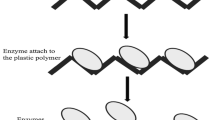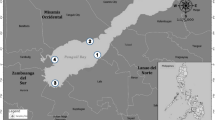Abstract
The polychaete Nereis diversicolor O.F. Müller was exposed to marine sediments which had been contaminated with plutonium and americium either through the testing of nuclear devices or by the release of liquid waste effluent from a nuclear fuel reprocessing plant. The uptake of both plutonium and americium was small, about 0.5% of the concentration of these transuranics in the sediments. The degree of relative uptake of plutonium from both sediments was comparable; relative uptake of americium from sediments contaminated by waste effluent was greater than that from nuclear sediment and those previously determined from water-uptake experiments to environmentally determined plutonium concentrations in sediments and overlying waters leads to the tentative conclusion that water may be the predominant pathway for plutonium accumulation by deposit-feeding worms like N. diversicolor.
Similar content being viewed by others
Literature Cited
Beasley, T.M. and S.W. Fowler: Plutonium and americium uptake from sediment by polychaete worms. In: Activities of the International Laboratory of Marine Radioactivity, 1976 Report, pp 55–66. Vienna: International Atomic Energy Agency 1976
Bojanowski, R., H.D. Livingston, D.L. Schneider and D.R. Mann: A procedure for analysis of americium in marine environmental samples. Int. atom. Energy Ag. tech. Rep. Ser. 169, 77–86 (1975)
Bowen, V.T., H.D. Livingston and J.C. Burke: Distribution of transuranium nuclides in sediment and biota of the North Atlantic Ocean. In: Transuranium nuclides in the environment, pp 107–120. Vienna: International Atomic Energy Agency 1976
Bryan, G.W. and L.G. Hummerstone: Adaptation of the polychaete Nereis diversicolor to estuarine sediments containing high concentrations of heavy metals. I. General observations and adaptation to copper. J. mar. biol. Ass. U.K. 51, 845–863 (1971)
——: Adaptation of the polychaete Nereis diversicolor to estuarine sediments containing high concentrations of zinc and cadmium. J. mar. biol. Ass. U.K. 53, 839–857 (1973)
Dean, J.M.: The accumulation of 65Zn and other radionuclides by tubificid worms. Hydrobiologia 45, 33–38 (1974)
Duursma, E.K. and P. Parsi: Distribution coefficient of plutonium between sediment and sea water. In: Activities of the International Laboratory of Marine Radioactivity, 1974 Report, IAEA-163, pp 94–96. Vienna: International Atomic Energy Agency 1974
Fowler, S.W., M. Heyraud and T.M. Beasley: Experimental studies on plutonium kinetics in marine biota. In: Impacts of nuclear releases into the aquatic environment, pp 157–177. Vienna: International Atomic Energy Agency (1975)
—— and R.D. Cherry: Accumulation and retention of plutonium by marine zooplankton. In: Activities of the International Laboratory of Marine Radioactivity, 1976 Report. pp 42–50. Vienna: International Atomic Energy Agency 1976
Goerke, H.: Die Ernährungsweise der Nereis-Arten (Polychaeta, Nereidae) der deutschen Küsten. Veröff. Inst. Meeresforsch. Bremerh. 13, 1–50 (1971)
Noshkin, V.E.: Ecological aspects of plutonium dissemination in aquatic environments. Hlth Phys. 22, 537–549 (1972)
—: Concentrations and distributions of long-lived fallout radionuclides in open ocean sediments: In: Radioactive contamination of the marine environment, pp 671–686. Vienna: International Atomic Energy Agency 1973
Noshkin, V.E., V.T. Bowen, K.M. Wong and J.C. Burke: Plutonium in North Atlantic Ocean organisms: ecological relationships. In: Radionuclides in ecosystems. Proc. natn. Symp. Radioecol. (Oak Ridge) 2, 681–688 (1971)
— and C. Gatrousis: Fallout 240Pu and 239Pu in Atlantic marine samples. Earth planet. Sci. Letters 22, 111–117 (1974)
Renfro, W.C.: Transfer of 65Zn from sediments by marine polychaete worms. Mar. Biol. 21, 305–316 (1973)
Wahlgren, M.A., J.J. Alberts, D.M. Nelson and K.A. Orlandini: Study of the behaviour of transuranics and possible chemical homologues in Lake Michigan water and biota. In: Transuranium nuclides in the environment, pp 9–24. Vienna: International Atomic Energy Agency 1976.
Author information
Authors and Affiliations
Additional information
Communicated by J.M. Pérès, Marseille
Rights and permissions
About this article
Cite this article
Beasley, T.M., Fowler, S.W. Plutonium and Americium: Uptake from contaminated sediments by the polychaete Nereis diversicolor . Mar. Biol. 38, 95–100 (1976). https://doi.org/10.1007/BF00390762
Accepted:
Issue Date:
DOI: https://doi.org/10.1007/BF00390762




